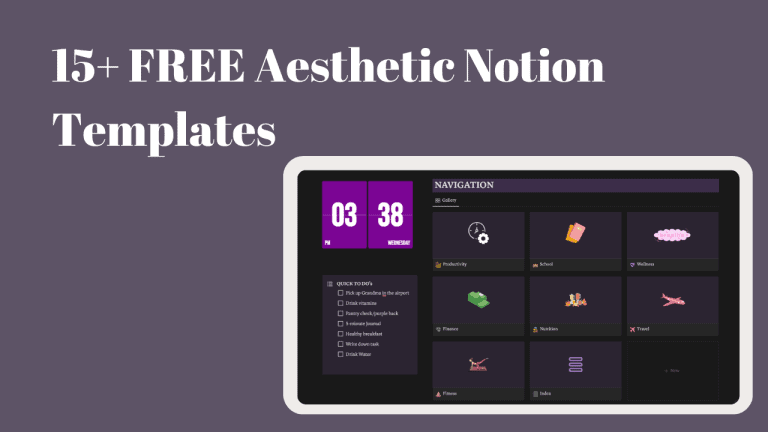Lovable dev Review: Build Apps 20× Faster with AI in 2025

Before now, building apps will require coding and web development skills and perhaps a little bit of web designing. Now, AI-powered app builders are speedingly emerging with the ability to transform natural language prompts into full-stack applications.
After trying numerous AI app builders that left much to be desired, I found Lovable.dev to stand out with its impressive abilities. Unlike many competitors that simply generate code snippets or basic prototypes, Lovable creates apps that are ready and functional.
In this comprehensive review, we’ll explore Lovable.dev’s features, usability, pricing, how it compares to alternatives and share some tips to get the best. Hang tight, this review will help you determine if Lovable.dev is the right tool for your needs.
What is Lovable.dev?
Lovable is an AI platform that allows you to create websites, apps, or virtually anything you can think of by just generating a few prompts. One cool thing about Lovable is that you can hook it up to your GitHub, and it will actually save all of this code to your GitHub, which is going to make it much easier to then edit the code locally on your computer or to share it with somebody else.
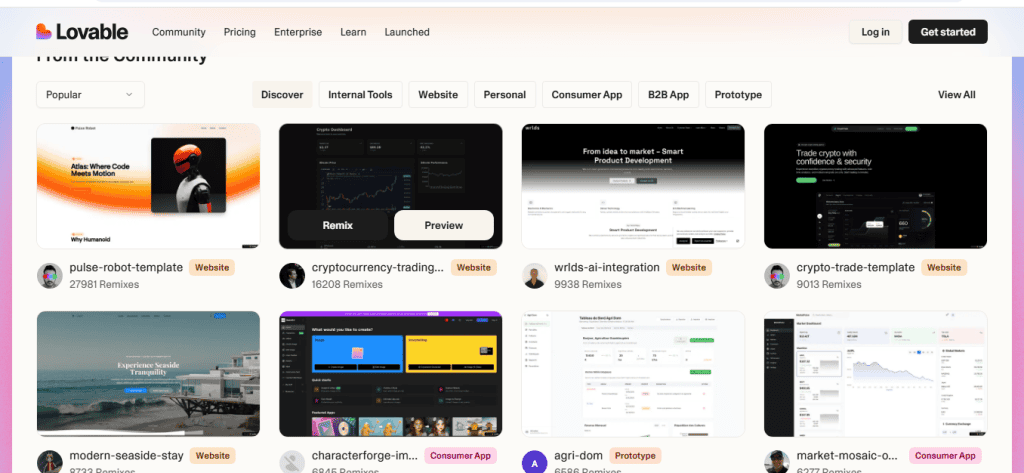
The core concept behind Lovable is straightforward: you describe what you want to build in plain English, and the AI generates all the necessary code and components.Perhaps you’re wondering how it happens. Under the hood, Lovable generates React + Tailwind CSS frontends with Vite, provisions backend code, and orchestrates databases and cloud deployment.
Getting Started with Lovable.dev
Getting started with Lovable.dev is straightforward. You can get started with Lovable completely for free. Just keep in mind the free version is a bit limited. They only give you a few credits a day. At the top right, click on get started to create a free account. You can also sign up with Google and GitHub if you want to go that route.
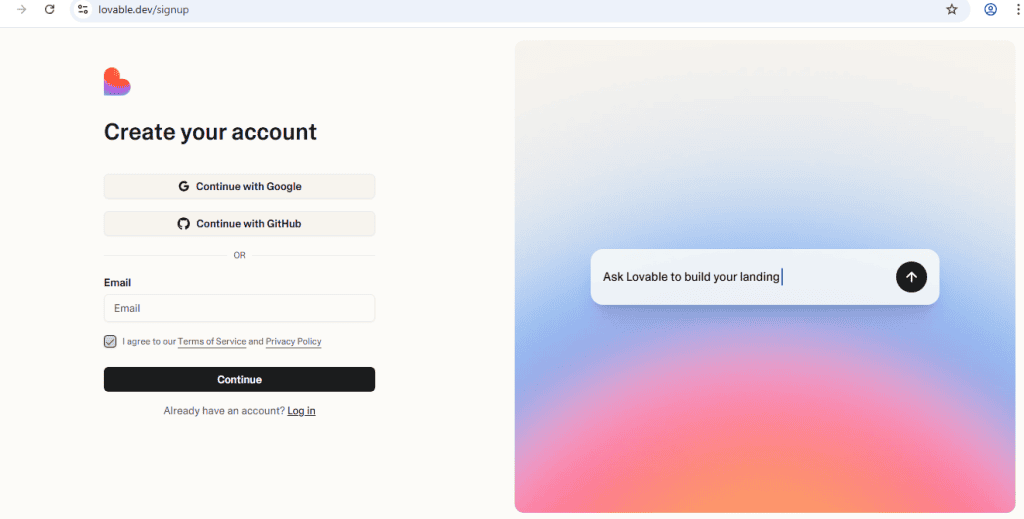
The next step is to check your email and confirm it with Lovable. You’ll be asked a few questions and you can select the mode you prefer (either light or dark). Some other questions will be asked but you can choose to skip this for now and get logged in with Lovable.
There are several ways to initiate a project in Lovable:
- Using natural language prompts: The most common approach is to describe what you want to build in the prompt box. The more specific and detailed your prompt, the better the results. A better approach is to converse with chatgpt to give you a descriptive prompts and then paste it.
- Starting from templates: Lovable offers templates for common project types to help you get started quickly. You can pick from the landing page, dashboard, tools and apps.
- Remixing existing projects: You can use public projects as starting points for your own applications. If you’re very creative enough you can tweak existing projects to a better version you desire.
- Using Figma designs: You can upload screenshots from Figma or use the Builder.io integration to convert designs directly into functional code. It’s important that you use Auto-Layout to structure your design so that the images will be converted to functional codes.
- Using sketches: Tools like Excalidraw can be used to sketch your UI, which Lovable will then transform into working code. Excalidraw is a whiteboard tool that you can use to draw sketches that feel handmade.
- Cloning existing websites: If you have a website that you desire so much and you don’t know how to replicate it, you can take screenshots of such websites and have Lovable recreate their structure by just pasting it.
Core Features of Lovable dev
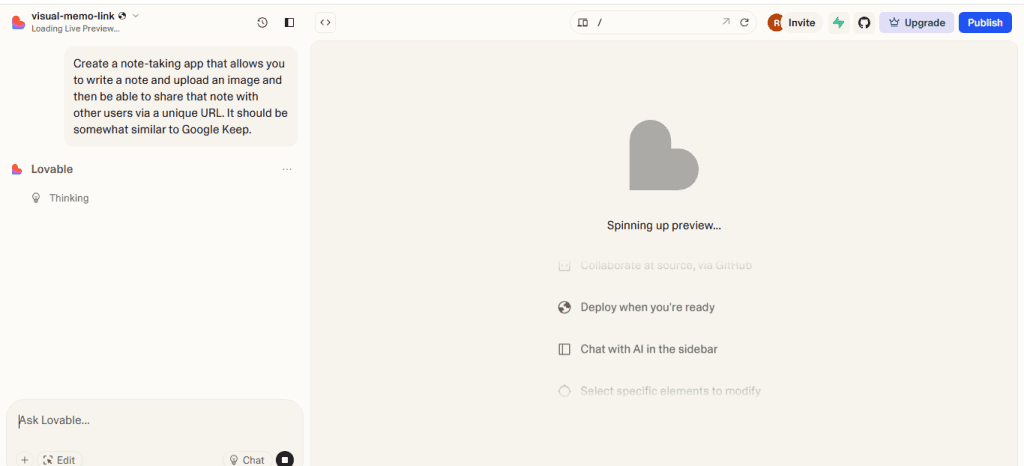
1. Natural Language to Code Workflow
As with most of these tools, you’re going to start out by typing a prompt in here that describes what you want to build. For example, you might prompt: “Create a note-taking app that allows you to write a note and upload an image and then be able to share that note with other users via a unique URL. It should be somewhat similar to Google Keep.”
Lovable will analyze your request and generate the required files. The code quality is generally high, with proper organization and commenting.
One impressive aspect is how quickly Lovable can generate substantial codebases. It can even create seven different files for a note-taking application in just minutes, complete with a well-formatted UI and functional components.
2. Supabase and GitHub Integrations
One of Lovable’s standout features is its deep integration with Supabase and GitHub. These integrations elevate it from a simple code generator to a comprehensive development platform.
Supabase allows you to store all of your application data in a real database, and it’s not going to just disappear when you reload. Make sure you’ve added your GitHub account to Lovable.
Click on the Edit Code button and Transfer Repository. You’ll be able to clone this repository on your desktop, and have it available locally for easy modifications. Lovable will be aware you made a change, so it’s going to go ahead and update its current state.
Lovable will handle the SQL generation for creating tables and storage buckets. This integration allows you to build full-stack applications with proper data persistence and user authentication without writing backend code.
3. Visual Editor and Real-Time Feedback
Lovable’s Visual Edits allows you to basically edit every part of your website. There’s text where you can adjust the contents, change the margin and padding, change the font size, the color, the background, and more advanced options.
Plus, the history feature helps you to revert to previous versions if needed. Every time you make an update, it saves and republishes the next version, but you can always go back to any previous revision.
4. Multiplayer Collaboration
In case you’ve multiple team members, they can actually work on the same project simultaneously. Each will have roles and permissions to different levels of access to projects. This collaborative environment makes the development process easier and enables faster iteration.
5. Custom Domain Support
Once your app is done and you’re ready to publish it, Lovable provides custom domain support. You can add an existing domain or purchase a new one directly through the platform. The best part is that it enhances your site’s professional appearance and improves SEO by keeping all traffic under your domain.
6. Chat Mode
You know, setting up a database, creating tables, managing different types, all of this stuff usually takes a lot more effort. Unlike Lovable, you can interact with your project in the Chat Mode without making direct code edits. This mode is perfect for asking questions, planning your project, and debugging issues.
Pricing Analysis
Lovable’s pricing structure is based on a credit system with several tiers:
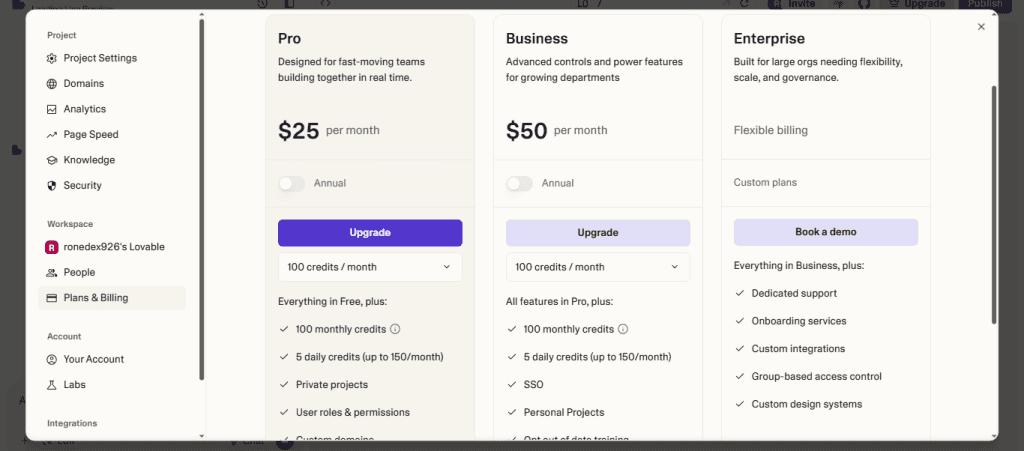
Free Plan
- 5 messages per day (30 monthly max)
- Unlimited public projects
- GitHub sync
- One-click deployment
The free plan is good for basic testing but too limited for serious development work. My rough estimate: I used over 100 credits to build a relatively simple note-taking application, which would quickly exhaust the free tier.
Pro Plan ($25/month)
- Personal workspace for the account holder
- Invite up to 2 collaborators to any project
- Guests draw from the project owner’s credit balance
- 100 monthly messages
Business Plan ($50/month)
- One shared workspace for up to 20 users
- Owners & admins can invite or remove members
- Editors can manage and edit existing projects
- Everyone taps into the same pooled credits
Enterprise Plan (Custom pricing)
- Custom message limits
- Centralized billing
- SSO integration
- Dedicated support
- Custom integrations
- Expert help with architecture and debugging
To be honest, if we compare it to other AI app builders, Lovable is on the more expensive side. At $20-25 per month for the basic paid plan, you only get 100 requests, which can be consumed quickly when developing even moderately complex applications.
But if we consider the integrations with Supabase and GitHub, which eliminate the need for separate services the value proposition becomes clearer. The ability to export and own your code also adds significant value compared to closed platforms.
Limitations and Drawbacks
Despite its impressive abilities, Lovable has several limitations to consider:
Advanced Coding Knowledge Requirements
While Lovable automates much of the development process, you still need some technical knowledge to:
- Fix broken logic
- Troubleshoot runtime issues
- Fine-tune designs for complex applications
Prompt Sensitivity and Stability Issues
The performance of Lovable depends heavily on the quality of your prompts. If you provide vague or ambiguous descriptions you’ll get incomplete or incorrect outputs. Additionally, model upgrades may introduce breaking changes to previously working flows. So you might need to adjust your prompting strategy.
Credit and Usage Limits
As mentioned earlier, the strict credit limits on free and starter plans make it difficult to explore or build larger projects without upgrading. This credit-based system can create friction during the development process. Sometimes you will be stuck to complete your project when you finish your credits or you may need to be conservative with your iterations to avoid hitting limits.
Lovable.dev vs. Alternative
1. Lovable vs. Bolt.new
Bolt.new is another AI that can convert natural language to code for generating full-stack apps:
- Speed: Both are fast, but Bolt emphasizes immediate preview and one-click deployment.
- Backend Integration: The Supabase integrated with Lovable adds more backend capabilities out of the box compared to Bolt.
- Code Access: Bolt’s is a more closed environment but Lovable uses GitHub to code better.
2. Lovable vs. DronaHQ
DronaHQ is a low-code internal tool. It’s also AI-Powered:
- Approach: Their approach sounds vice versa. DronaHQ uses a visual builder with AI assistance, while Lovable is primarily AI-generated code with visual editing.
- Enterprise Features: Unlike Lovable, DronaHQ has better enterprise features like role-based access and audit logs.
3. Lovable vs. Traditional Development
Compared to traditional coding:
- Speed: Lovable is very fast in building both simple and complex apps.
- Learning Curve: Even if you don’t have expertise in web development, you can find your way around Lovable and get your work done but it doesn’t eliminate the need for knowledge.
- Maintenance: Traditional code may be easier to maintain long-term for complex applications.
Who Should Use Lovable.dev?
The below set of people can use Lovable successfully:

1. Non-technical Founders and Entrepreneurs
Lovable helps people with creative and problem-solving ideas who lack coding skills to bring their dreams to reality. Just be good at simple language prompts and you won’t need to hire developers.
2. Product Teams
Most times Non-technical team members failed to contribute directly to development in the company. Teams can now maximize Lovable to build real prototypes rather than just describing them.
3. Designers
Designers can turn their ideas into functional applications without spending hours in tools like Figma. The platform converts design file screenshots directly into working code.
4. Experienced Developers
Software engineers can use Lovable to create entire frontends with one prompt. This will help save time on basic tasks. It’s particularly useful for scaffolding projects and generating boilerplate code.
Tips for Getting the Most Out of Lovable.dev
I promised to share some tips to maximize your experience with Lovable, and I’ll do that now:
1. Create Detailed Prompts
You can’t get your desired output by just stating your objective, you must also state the path. Use ChatGPT or similar tools to generate comprehensive descriptions and mention things pertaining to:
- Color themes and font styles
- Design preferences and inspiration
- Specific features and functionality
- User flows and interactions
The more specific you are, the better the results will be.
2. Refactor Proactively
Avoid working with long and bogus files. As your application grows, break large components into smaller and more manageable pieces. Sometimes Lovable does suggest you refactor when files become too long. This makes it easier for the AI to understand and modify your code.
3. Leverage GitHub Integration
GitHub integration is the best thing ever you shouldn’t ignore. Take full advantage of the GitHub integration by:
- Cloning repositories locally for detailed editing
- Using traditional development tools for complex changes
- Committing changes back to GitHub for Lovable to incorporate
- Maintaining proper version control practices
4. Use Visual Editing for Fine-Tuning
While many believe that performance is important most visitors would enjoy visiting a visually appealing application. The Visual Edits feature is your painting brush for making precise UI adjustments. Use it for:
- Adjusting spacing and alignment
- Modifying colors and typography
- Rearranging components
- Fine-tuning responsive behavior
5. Combine AI Generation with Manual Editing
The development of Artificial Intelligence is not to replace humans completely but to assist in getting better and faster results. For the best results, use Lovable to generate the initial structure and basic functionality, then refine the details manually.
6. Test Thoroughly
Always test your application thoroughly, especially after making significant changes. Pay particular attention to:
- Form submissions and data persistence
- Authentication flows
- File uploads and storage
- Responsive behavior on different devices
Conclusion and Verdict
Lovable dev is a successful bridge in the gap between no-code platforms and traditional development. It has more speed, accessibility, flexibility and control than traditional development.
Two integrations elevate it above many competitors; Supabase and GitHub. They provide a comprehensive development environment rather than just a code generator.
Startups, small teams, and individual developers found it tremendously valuable because they can create a functional application in hours rather than days or weeks, reducing costs in the process.
However, the credit-based pricing model can become restrictive for larger projects, and complex applications may still require significant manual intervention.
As AI development tools continue to evolve, Lovable is one of the more mature and practical options available today. Don’t just describe your idea, build it and have fun while you turn to a developer overnight.
FAQ Section
Can I export my code from lovable.dev?
Yes, GitHub integration allows you to commit all generated code to your own repository. This gives you full ownership and control over your code.
Does lovable.dev support custom domains?
Yes, Lovable.dev has custom domain support. You can add an existing domain or purchase a new one directly through the platform.
What kind of apps can I build with lovable.dev?
You can build a wide range of applications with Lovable.dev, including web applications, admin panels, dashboards, CRUD applications, authentication systems, and more.


